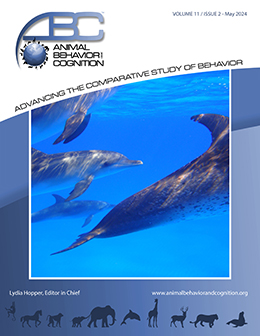Vol 11, Issue 2, May 2024
Nursing Behavior of Bottlenose Dolphin (Tursiops truncatus) Calves from 1990-2014 at Brookfield Zoo Chicago, USA
Citation
Ramont, M., Sholar, J., Stacey, R., Gonka, M., & Miller, L. J. (2024). Nursing Behavior of Bottlenose Dolphin (Tursiops truncatus) Calves from 1990-2014 at Brookfield Zoo Chicago, USA. Animal Behavior and Cognition, 11(1), 198-207. https://doi.org/10.26451/abc.11.01.04.2024
Abstract
While the common bottlenose dolphin (Tursiops truncatus) population under managed care in North American zoos and aquariums is self-sustaining, understanding normal nursing behavior can help management make informed care decisions for neonates and future births. This study examined behavioral data from the first 30 days of life collected from 14 dolphin calves born between 1990-2014 at Brookfield Zoo Chicago in Brookfield, IL. We hypothesized that surviving calves showed significantly different patterns of nursing than those that did not survive. There were no significant differences in average nursing rates or average nursing frequency between calves that did and did not survive up to 17 days old. Surviving calves up to eight days old had significantly longer average nursing performance (s/hr), and significantly longer average nursing durations (s/bout) than non-surviving calves. Shorter nursing duration early in the life of the calf may be indicative of developmental problems and may be a useful metric to inform staff when supplemental care may be needed. Calf survival improved from the first half to the second half of the study period by 150%, most likely due to improvements in animal care, medical intervention, and experience of the dams. Understanding normal nursing behavior is essential to learning when human intervention is necessary to help survival and can help guide future care and management of dolphin births under professional care.
Keywords
Bottlenose dolphin, Tursiops truncatus, Nursing behavior, Neonate
